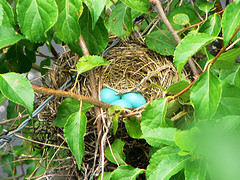The first thing to do is search websites such as:
Www.rspb.org.uk/wildlife/birdguide/name/.../robin/index.aspx
Look at the website above to check if the egg is healthy. After doing this the way of looking after the egg is the same as looking after any egg from any other bird. The egg needs to be kept warm, at the similar temperature of that of a mother robin would be. The egg should hatch after about a 13 day incubation period.
The chicks hatch naked, and are totally dependent on their parents for food and warmth. Both parents look after the nestlings. Feather growth will become evident with the appearance of quills at three days of age. By five days the eyes start to open and they are completely open by eight days.
By this time, rows of feathers will start to appear on backs and flanks. The body is more or less feathered by 10 days. Flight feathers are the last to grow, and as the chicks fledge at 14 days, they will not be able to fly for another couple of days.
The young are tended by their parents for up to three weeks after fledging. Frequently the care of the fledged young is left to the male, while the female prepares herself for the next nesting effort. Robins have two broods a year. Three successful broods a year is not uncommon, and in a good year even four are known.
These multiple broods result in a long breeding season, and nestlings can be found until late July. There are considerable losses during the egg and chick stage only about 57% of eggs from completed clutches result in fledged youngsters.
Despite being fiercely territorial against their own kind, robins do not normally bother about birds of other species near their nests. The parental instincts of robins are highly developed, which has led to the frequent reports of robins feeding the chicks or fledglings of other species. The most regular recipients of this unexpected care are song thrush, blackbird, spotted flycatcher and willow warbler.
Www.rspb.org.uk/wildlife/birdguide/name/.../robin/index.aspx
Look at the website above to check if the egg is healthy. After doing this the way of looking after the egg is the same as looking after any egg from any other bird. The egg needs to be kept warm, at the similar temperature of that of a mother robin would be. The egg should hatch after about a 13 day incubation period.
The chicks hatch naked, and are totally dependent on their parents for food and warmth. Both parents look after the nestlings. Feather growth will become evident with the appearance of quills at three days of age. By five days the eyes start to open and they are completely open by eight days.
By this time, rows of feathers will start to appear on backs and flanks. The body is more or less feathered by 10 days. Flight feathers are the last to grow, and as the chicks fledge at 14 days, they will not be able to fly for another couple of days.
The young are tended by their parents for up to three weeks after fledging. Frequently the care of the fledged young is left to the male, while the female prepares herself for the next nesting effort. Robins have two broods a year. Three successful broods a year is not uncommon, and in a good year even four are known.
These multiple broods result in a long breeding season, and nestlings can be found until late July. There are considerable losses during the egg and chick stage only about 57% of eggs from completed clutches result in fledged youngsters.
Despite being fiercely territorial against their own kind, robins do not normally bother about birds of other species near their nests. The parental instincts of robins are highly developed, which has led to the frequent reports of robins feeding the chicks or fledglings of other species. The most regular recipients of this unexpected care are song thrush, blackbird, spotted flycatcher and willow warbler.

